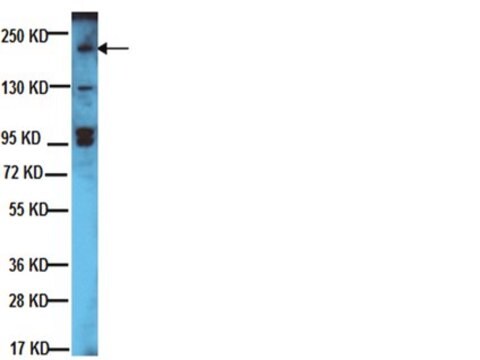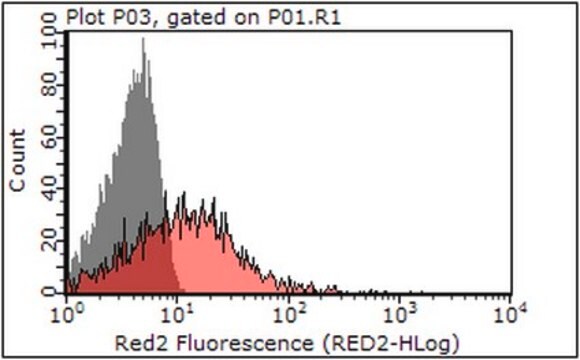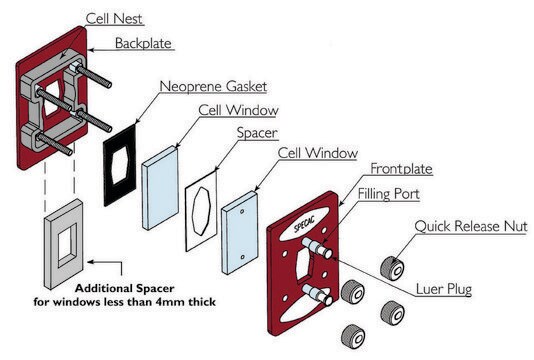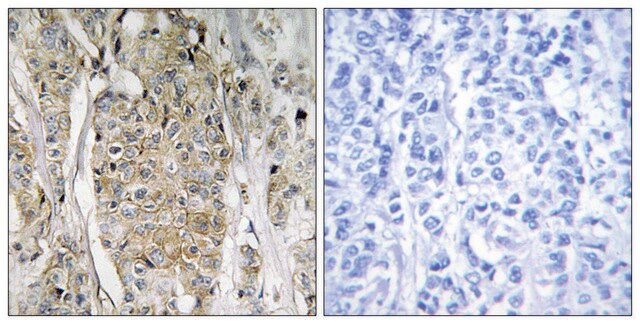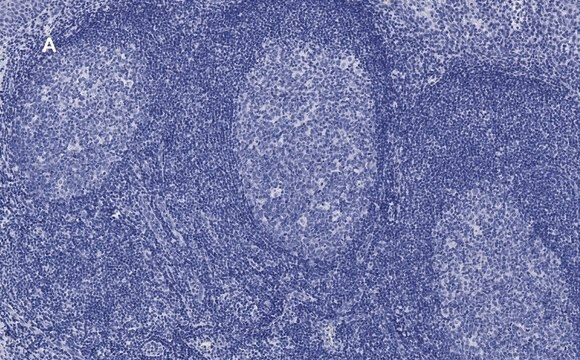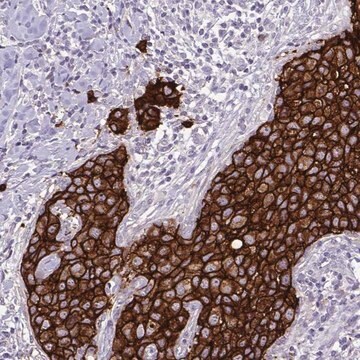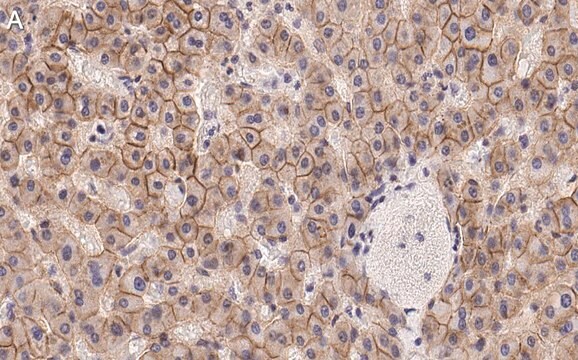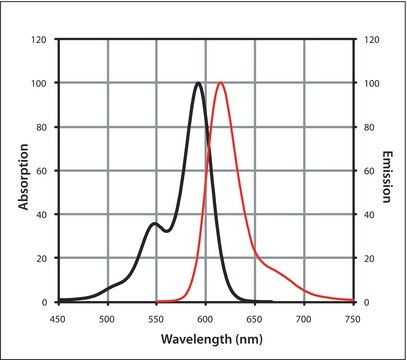General description
We are committed to bringing you greener alternative products, which adhere to one or more of The 12 Principles of Green Chemistry.This antibody is Preservative-free, produced without the harm or sacrifice of animals and exceptionally stable to allow for ambient shipping and storage if needed and thus aligns with "Waste Prevention", "Designing Safer Chemicals" and "Design for Energy Efficiency".
Click here for more information.
ZooMAb® antibodies represent an entirely new generation of recombinant monoclonal antibodies.Each ZooMAb® antibody is manufactured using our proprietary recombinant expression system, purified to homogeneity, and precisely dispensed to produce robust and highly reproducible lot-to-lot consistency. Only top-performing clones are released for use by researchers. Each antibody is validated for high specificity and affinity across multiple applications, including its most commonly used application. ZooMAb® antibodies are reliably available and ready to ship when you need them.
Specificity
Clone 1B13 is a Rabbit recombinant monoclonal antibody that specifically detects Receptor tyrosine-protein kinase erbB-2 (ErbB2/HER-2). It targets an epitope within 24 amino acids from the C-terminal region.
Immunogen
KLH-conjugated linear peptide corresponding to 24 amino acids from the C-terminal region of human Receptor tyrosine-protein kinase erbB-2 (ErbB2/HER-2).
Application
Quality Control Testing
Evaluated by Western Blotting in SK-BR3 cell lysate.
Western Blotting Analysis: A 1:10,000 dilution of this antibody detected ErbB2/HER-2 in SK-BR3 cell lysate.
Tested applications
Flow Cytometry Analysis: 1 μg from a representative lot detected ErbB2/HER-2 in one million MCF-7 cells.
Immunocytochemistry Analysis: A 1:100 dilution from a representative lot detected ErbB2/HER-2 in MCF-7 cells.
Immunohistochemistry (Paraffin) Analysis: A 1:100 dilution from a representative lot detected ErbB2/HER-2 in human urinary bladder tissue sections.
Affinity Binding Assay: A representative lot of this antibody bound ErbB2 with a KD of 1.4 x 10-8 in an affinity binding assay.
Note: Actual optimal working dilutions must be determined by end user as specimens, and experimental conditions may vary with the end user
Anti-ErbB2/HER-2, clone 1B13 ZooMAb®, Cat. No. ZRB1245, is a recombinant Rabbit monoclonal antibody that targets ErbB2/HER-2 and is tested in Affinity Binding Assay, Flow Cytometry, Immunocytochemistry, Immunohistochemistry, and Western Blotting.
Target description
Receptor tyrosine-protein kinase erbB-2 (UniProt: P04626; also known as EC:2.7.10.1, Metastatic lymph node gene 19 protein, MLN 19, Proto-oncogene Neu, Proto-oncogene c-ErbB-2, Tyrosine kinase-type cell surface receptor HER2, p185erbB2, CD340) is encoded by the ERBB2 (also known as HER2, MLN19, NEU, NGL) gene (Gene ID: 2064) in human. ErbB2 is a single-pass type I membrane glycoprotein that is synthesized with a signal peptide (aa 1-22), which is subsequently cleaved off to generate the mature form that contains an extracellular domain (aa 23-652), a transmembrane domain (aa 653-675), and a cytoplasmic domain (aa 676-1255). Its tyrosine kinase domain is localized to amino acids 720-987. It can also be translocated to the nucleus and its nuclear localization signal resides in amino acids 676-689. It has intrinsic protein tyrosine kinase activity and it mediates the lateral signal transduction of all ErbB receptors. It is involved in in the regulation of a variety of cellular functions, including cell growth, differentiation, and apoptosis. It also regulates outgrowth and stabilization of peripheral microtubules. In the nucleus it is involved in transcriptional regulation and associates with the 5′-TCAAATTC-3′ sequence in the PTGS2/COX-2 promoter and activates its transcription. It is also implicated in transcriptional activation of p21. ERBB2 gene is reported to be overexpressed in about 30% of all human breast carcinomas. ErbB2 is activated by dimerization and autophosphorylation. Ligand-binding is shown to increase phosphorylation on tyrosine residues. This ZooMAb® recombinant monoclonal antibody, generated by our propriety technology, offers significantly enhanced specificity, affinity, reproducibility, and stability over conventional monoclonals. (Ref.: Joshi, SK., et al. (2020). Leukemia. 34(10); 2798-2804).
Physical form
Purified recombinant rabbit monoclonal antibody IgG, lyophilized in PBS with 5% Trehalose, normal appearance a coarse or translucent resin. The PBS/trehalose components in the ZooMAb® formulation can have the appearance of a semi-solid (bead like gel) after lyophilization. This is a normal phenomenon. Please follow the recommended reconstitution procedure in the data sheet to dissolve the semi-solid, bead-like, gel-appearing material. The resulting antibody solution is completely stable and functional as proven by full functional testing. Contains no biocide or preservatives, such as azide, or any animal by-products. Larger pack sizes provided as multiples of 25 μL.
Reconstitution
300 μg/mL after reconstitution at 25 μL per vial. Please refer to guidance on suggested starting dilutions and/or titers per application and sample type.
Storage and Stability
Recommend storage of lyophilized product at 2-8°C; Before reconstitution, micro-centrifuge vials briefly to spin down material to bottom of the vial; Reconstitute each vial by adding 25 μL of filtered lab grade water or PBS; Reconstituted antibodies can be stored at 2-8°C, or -20°C for long term storage. Avoid repeated freeze-thaws.
Legal Information
ZooMAb is a registered trademark of Merck KGaA, Darmstadt, Germany
Disclaimer
Unless otherwise stated in our catalog or other company documentation accompanying the product(s), our products are intended for research use only and are not to be used for any other purpose, which includes but is not limited to, unauthorized commercial uses, in vitro diagnostic uses, ex vivo or in vivo therapeutic uses or any type of consumption or application to humans or animals.

